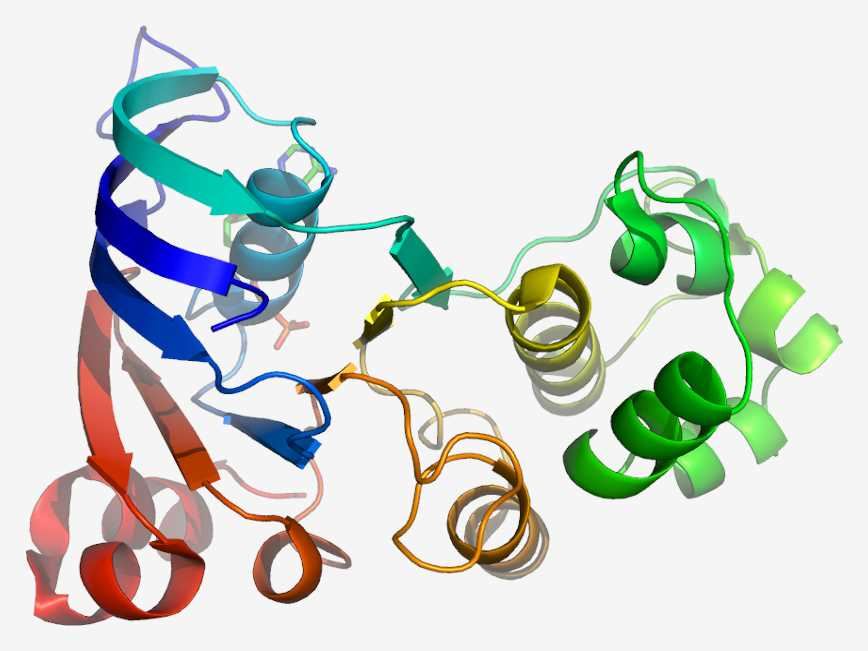Introduction of ABCC1
ABCC1, also known as MRP1, is a member of the superfamily of ATP-binding cassette (ABC) transporters which transport various molecules across extra- and intracellular membranes. There are seven subfamilies in ABC superfamily named as ABC1, MDR/TAP, MRP, ALD, OABP, GCN20, White, respectively. ABCC1 protein belongs to MRP subfamily. It is a 190 kDa protein with three membrane-spanning domains that contains 17 transmembrane helixes, and two nucleotide binding domains. ABCC1 is expressed in most human tissues, especially in lungs, kidneys, placenta, bladder, and adrenal glands, even in the endothelium cells of the blood-brain barrier.
| Basic Information of ABCC1 | |
| Protein Name | Multidrug resistance-associated protein 1 |
| Gene Name | ABCC1 |
| Aliases | MRP, ABCC, GS-X, MRP1, ABC29 |
| Organism | Homo sapiens (Human) |
| UniProt ID | P33527 |
| Transmembrane Times | 17 |
| Length (aa) | 1541 |
| Sequence | MALRGFCSADGSDPLWDWNVTWNTSNPDFTKCFQNTVLVWVPCFYLWACFPFYFLYLSRHDRGYIQMTPLNKTKTALGFLLWIVCWADLFYSFWERSRGIFLAPVFLVSPTLLGITMLLATFLIQLERRKGVQSSGIMLTFWLVALVCALAILRSKIMTALKEDAQVDLFRDITFYVYFSLLLIQLVLSCFSDRSPLFSETIHDPNPCPESSASFLSRITFWWITGLIVRGYRQPLEGSDLWSLNKEDTSEQVVPVLVKNWKKECAKTRKQPVKVVYSSKDPAQPKESSKVDANEEVEALIVKSPQKEWNPSLFKVLYKTFGPYFLMSFFFKAIHDLMMFSGPQILKLLIKFVNDTKAPDWQGYFYTVLLFVTACLQTLVLHQYFHICFVSGMRIKTAVIGAVYRKALVITNSARKSSTVGEIVNLMSVDAQRFMDLATYINMIWSAPLQVILALYLLWLNLGPSVLAGVAVMVLMVPVNAVMAMKTKTYQVAHMKSKDNRIKLMNEILNGIKVLKLYAWELAFKDKVLAIRQEELKVLKKSAYLSAVGTFTWVCTPFLVALCTFAVYVTIDENNILDAQTAFVSLALFNILRFPLNILPMVISSIVQASVSLKRLRIFLSHEELEPDSIERRPVKDGGGTNSITVRNATFTWARSDPPTLNGITFSIPEGALVAVVGQVGCGKSSLLSALLAEMDKVEGHVAIKGSVAYVPQQAWIQNDSLRENILFGCQLEEPYYRSVIQACALLPDLEILPSGDRTEIGEKGVNLSGGQKQRVSLARAVYSNADIYLFDDPLSAVDAHVGKHIFENVIGPKGMLKNKTRILVTHSMSYLPQVDVIIVMSGGKISEMGSYQELLARDGAFAEFLRTYASTEQEQDAEENGSTVMDEEEAGVTGVSGPGKEAKQMENGMLVTDSAGKQLQRQLSSSSSYSGDISRHHNSTAELQKAEAKKEETWKLMEADKAQTGQVKLSVYWDYMKAIGLFISFLSIFLFMCNHVSALASNYWLSLWTDDPIVNGTQEHTKVRLSVYGALGISQGIAVFGYSMAVSIGGILASRCLHVDLLHSILRSPMSFFERTPSGNLVNRFSKELDTVDSMIPEVIKMFMGSLFNVIGACIVILLATPIAAIIIPPLGLIYFFVQRFYVASSRQLKRLESVSRSPVYSHFNETLLGVSVIRAFEEQERFIHQSDLKVDENQKAYYPSIVANRWLAVRLECVGNCIVLFAALFAVISRHSLSAGLVGLSVSYSLQVTTYLNWLVRMSSEMETNIVAVERLKEYSETEKEAPWQIQETAPPSSWPQVGRVEFRNYCLRYREDLDFVLRHINVTINGGEKVGIVGRTGAGKSSLTLGLFRINESAEGEIIIDGINIAKIGLHDLRFKITIIPQDPVLFSGSLRMNLDPFSQYSDEEVWTSLELAHLKDFVSALPDKLDHECAEGGENLSVGQRQLVCLARALLRKTKILVLDEATAAVDLETDDLIQSTIRTQFEDCTVLTIAHRLNTIMDYTRVIVLDKGEIQEYGAPSDLLQQRGLFYSMAKDAGLV |
Function of ABCC1 Membrane Protein
ABCC1 has been revealed to exert an essential role in the regulation of cellular oxidative stress and redox homeostasis. It is a typical ATP-dependent transporter of multispecific organic anions with a high affinity for glutathione (GSH) conjugates. ABCC1 also transports leukotriene C4 (LTC4), estradiol-17β-glucuronate, sulfated bile acids, bilirubin, and folate. Moreover, ABCC1 has been also suggested to be a transporter for glucuronides and sulfate conjugates of steroid hormones and bile salts. Recently, some studies reported that ABCC1 is most present at the blood-brain barrier and plays a role in the protection of the brain from xenobiotics along with P-gp and BCRP. And ABCC1 can decrease β-amyloid accumulation and involves in the progression of Alzheimer’s disease. In addition, ABCC1 has been revealed to be responsible for multiple drugs resistance such as anthracyclines, camptothecins, vinca alkaloids, a few kinase inhibitors, etoposide, irinotecan, SN-38, and methotrexate. The overexpression of ABCC1 is found in many tumor tissues and involves in the resistance of chemotherapeutic drugs thereby impacting the therapeutic process. In lung carcinoma, higher expression of ABCC1 is associated with a decreased sensibility to chemotherapeutic drugs and survival rate.
 Fig.1 Structure of ABCC1 protein.
Fig.1 Structure of ABCC1 protein.
Application of ABCC1 Membrane Protein in Literature
The study shows that the Phe583 side-chain of ABCC1 is very important for its transport function. The loss of F583A Phe583 side-chain can alter the solute binding and nucleotide binding regions of the transporter, thereby making ABCC1 in a low-affinity solute binding state.
The study reveals that long non-coding RNA KCNQ1OT1 participates in the regulation of oxaliplatin resistance in hepatocellular carcinoma cells through miR-7-5p/ABCC1 pathway, which suggests a potential therapeutic strategy for hepatocellular carcinoma.
The study indicates that miR-1268a regulates temozolomide resistance in glioblastoma through controlling the expression of ABCC1.
The study shows that multiple factors including cell and tissue type influence the efflux of different arsenic metabolites by MRP1. This suggests the effect of MRP1 on both tissue-specific risks to arsenic-induced disease and tumor sensitivity to arsenic-based therapeutics.
The study reveals that transporters MRP1 and MRP2 play an important role in the neutrophil control in the lung. This suggests the potential therapeutic targets to decrease excess inflammation, thereby reducing the susceptibility of developing bacteremia during pneumococcal pneumonia.
ABCC1 Preparation Options
To obtain the soluble and functional target protein, the versatile Magic™ membrane protein production platform in Creative Biolabs enables many flexible options, from which you can always find a better match for your particular project. Aided by our versatile Magic™ anti-membrane protein antibody discovery platform, we also provide customized anti-ABCC1 antibody development services.
As a forward-looking research institute as well as a leading custom service provider in the field of membrane protein, Creative Biolabs has won good reputation among our worldwide customers for successfully accomplishing numerous challenging projects including generation of many functional membrane proteins. Please feel free to contact us for more information.
All listed services and products are For Research Use Only. Do Not use in any diagnostic or therapeutic applications.